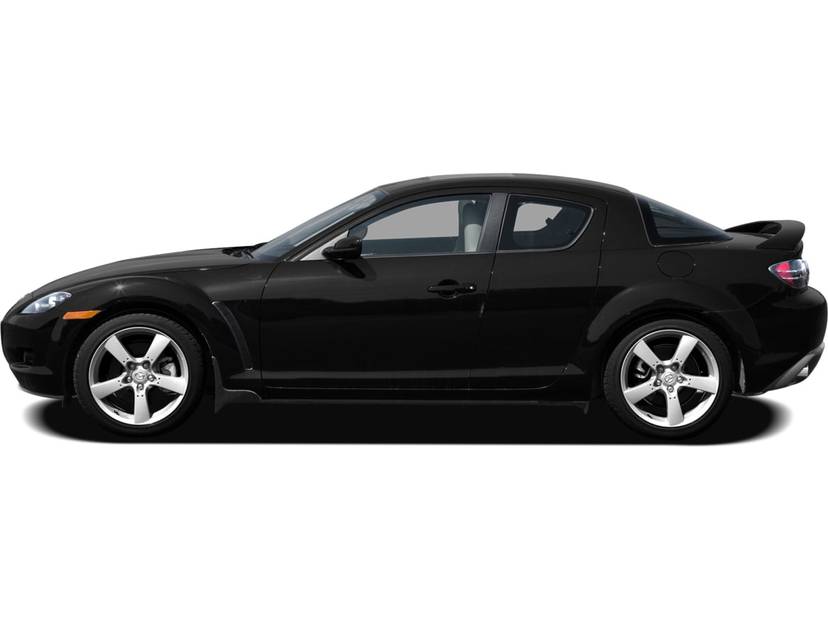
Sporty Mazda RX-8 a top place finisher
Rear clamshell doors enhance the Mazda RX-8’s sleek profile, while a sophisticated-looking interior adds to the coupe’s design.
Mazda RX-8 steps out as a distinctively different sort of sports car.
From its sweetly smooth and potent rotary engine to its clamshell back doors, RX-8 cuts its own swath among today’s wide-ranging crop of performance machines. Add to that razor-sharp handling and response and lithe styling that looks racy from any angle.
After a nine-year absence, Mazda’s rotary engine is back, last seen in the 1995 RX-7. The redesigned rotary, a new generation that Mazda calls Renesis, is unique among automobile engines. Every other internal-combustion engine out there works on the same principal: the exploding fuel pushes down pistons that are connected to a rotating crankshaft.
RX-8’s rotary engine, also known as Wankel after its 1920s German inventor, uses a pair of triangular-shaped rotors that spin through an asymmetrical pattern inside an oval combustion chamber.
There are still valves and spark plugs, and the fuel is still gasoline. The rotary’s advantage is its compact size, less than half the bulk of a comparable piston engine, while producing considerably more power. Early rotaries had problems with durability and poor fuel mileage, but Mazda seems to have those things licked.
Mileage still could be better.
The engine’s small dimensions allow it to be mounted well aft of the front wheels, producing the neutral handling of a midengine car.
The clamshell rear doors that open rearward help RX-8 maintain the profile of a two-door sport coupe while permitting access to the back seats. The doors are not new – Saturn had them first – but work out especially well for a car trying to be practical as well as sporting.
Mazda, backed with cash from ownership by Ford, has produced some highly favorable automobiles in the past couple of years. The RX-8 provides the halo for the company’s renaissance.
What it is
A four-door sports car dressed as a coupe with enough power and handling finesse to justify its low, lean looks.
Performance
RX-8 is the only production car powered by a rotary engine. Mazda and a few European manufacturers experimented with rotaries in the ’60s and ’70s, but the engines earned a bad reputation for blowing seals and smoking up the atmosphere. They were also gas hogs, not a good thing during the ’70s fuel crises.
By the time RX-7 came out in 1979, the problems were substantially engineered out of the rotary. The RX-8’s engine represents a major step forward. Improvements in intake and exhaust porting give the Renesis engine more power and tractability while producing fewer exhaust emissions.
The tiny 1.3-liter engine produces 238 horsepower with the six-speed transmission and 197 with automatic, with industry repo rts showing the stickshift version as the overwhelming favorite. Mazda originally overstated engine power, which resulted in a brief controversy and a $500 payback to the original owners.
Whatever the numbers are, the rotary engine provides strong performance across its wide RPM range, with the red line set at a soaring 9,000 rpm. The torque is relatively low, just 159 pound-feet at 5,000 RPM, so standing starts are not all that impressive.
But once you get those rotors humming, the Mazda hunkers down and runs. On back roads, the engine’s wide power band makes it feel like an expensive European exotic.
Full mileage is disappointing, estimated by EPA at 18 city and 24 highway.
Drivability
The RX-8’s remarkable balance makes it a treat to dice through turns, responding well to throttle and steering inputs with an absolutely neutral handling bias.
The suspension is not harsh, either, letting RX-8 serve as a cross-country touring ca as well as a sports car. It does earn a demerit for road noise, with too much rumble and roar from the performance tires, transmitted to the cabin.
The steering is assisted electrically, nicely weighted with just enough feedback. The four-wheel disc brakes are really strong, more like Porsche than Mazda.
Styling
The back seat with clamshell doors makes the passenger compartment look a bit stretched, but the overall look conveys RX-8s purposeful and athletic intent.
Interior Those back seats are a nice addition, but only if everybody on board is small. Otherwise, consider it a nicely upholstered package compartment. The rear doors make access convenient, not necessarily for passengers but for retrieving those packages.
Front seats are supportive, with plenty of legroom and headroom.
The dashboard design is fairly generic, though with a quality feel throughout. The gauges are weird, the tachometer small and hard to read and the speedometer an ugly digital affair.
Pricing
Well-equipped, RX-8 starts at a reasonable $26,680 for the six-speed version, or $25,180 for the less-powerful automatic. The test car was decked out with a $4,000 Grand Touring package, which includes Dynamic Stability Control and traction control, xenon headlights, leather upholstery, moonroof, and Bose audio system; $2,000 for a GPS navigation system; $395 for a full-size spare tire; $139 for a body-accent package; and $520 for shipping.
Even loaded with goodies, RX-8 is still a moderate $33,734.
Bottom line
A unique and capable sports car that’s usable as an everyday vehicle and available at a reasonable price.
Mazda RX-8
Vehicle type:
Four-passenger, four-door sports coupe, rear-wheel drive.
Base price:
$26,680.
Price as tested:
$33,734.
Engine:
1.3-liter twin rotor, 238 horsepower at 8,500 rpm, 159 pound-feet of torque at 5,500 rpm.
Transmission:
Six-speed stickshift.
Wheelbase:
106.4 inches.
Curb weight:
3,029 pounds.
EPA mileage:
18 city, 24 highway.
Highs:
Balanced handling.
Smooth engine power.
Athletic styling.
Lows:
Scant engine torque.
Road roar.
Ugly gauges.






